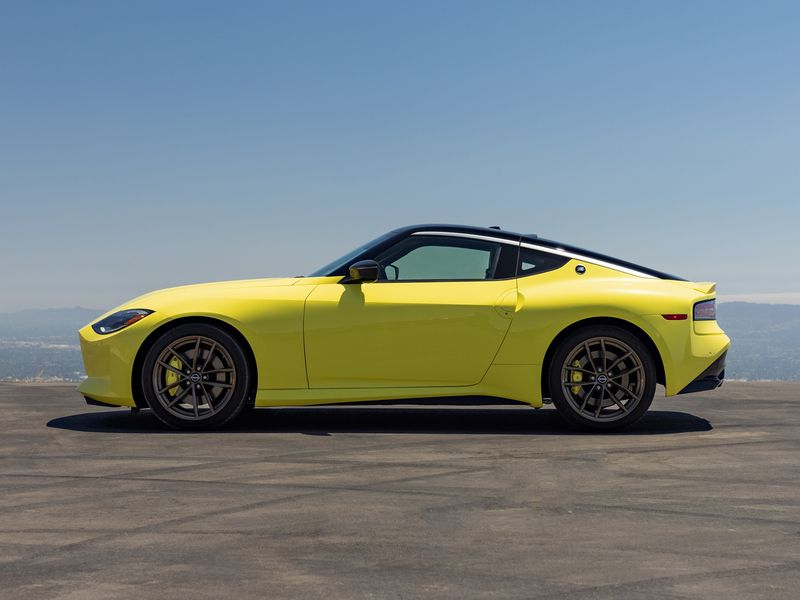
TOKYO — This might be the age of the electric, but Nissan just redesigned its iconic Z car with a boost of gasoline-powered horsepower.
With a high-output 3.0-liter V6 powerplant, the new Z is a 400-hp, twin-turbo, retro-styled piece of eye candy, gaining 68 hp and a 30 percent increase in torque. It is also quicker off the line, eking a 15 percent improvement in the car’s 0 to 60 mph time.
It’s the first time the Z has packed 400 or more hp.
Retro-styled on the outside, high-tech on the inside, the redesign is partly homage to the car’s origins and partly a signal for Nissan’s new direction.
With its global sales focused mainly on the U.S. and Japan, the Z is expected to be more of a brand builder than volume player.
Indeed, the Z is a key element in CEO Makoto Uchida’s “Nissan A to Z” product blitz, which aims to rejuvenate an aging lineup with a steady stream of new offerings. The “A” stands for the new Ariya electric crossover, and the “Z” is for the new sports coupe. Other important redesigns include the Rogue and Pathfinder crossovers, Frontier midsize pickup and Sentra compact sedan.
Nissan also is dumping the sports car’s numeric nomenclature.
When the long-awaited redesign — its first since 2009 — lands in U.S. lots next spring, it will be rechristened simply as the “Z.” That squashes speculation that the update might succeed the current 370Z as the 400Z, in a nod to its pumped-up horsepower and performance.
In a world seemingly gone gaga for all things electric, the Z is a no-excuses, gasoline-burning speedster. But Nissan also is pitching it as a heritage car, one “built for enthusiasts, by enthusiasts.”
“The new Z retains its authenticity as a pure sports car to keep you connected to the road while bringing in the latest modern technologies to make sure the car can help keep you connected to your life,” Nissan COO Ashwani Gupta said in a statement announcing the new car.
Among the Z’s throwbacks to the first-generation 240Z, which debuted some five decades ago under the Datsun brand in the U.S., is the signature silhouette — a long hood, pointy nose and short, sloping rear deck that tails off slightly lower than the front fender.
While Nissan has not announced pricing, the next Z is expected to remain true to its “accessible” sports car roots with a sticker starting around $40,000.
Some of the 21st-century accoutrements include LED headlamps and a 12.3-inch digital meter display. A plethora of modern upgrades include intelligent cruise control, an auto-dimming rearview mirror, a review monitor, USB ports and front and rear sonar sensors.
Under the hood, the new Z gets a robust 3.0-liter twin-turbo V-6 engine adapted from the one in the Infiniti Q50 Red Sport 400. Its 400 hp is achieved using small-diameter turbochargers as well as a turbo speed sensor in conjunction with an electronic variable valve timing intake system. The combination improves both response and fuel economy, depending on the driving scenario.
The standard setup mates the engine to a six-speed manual transmission, with an Exedy high-performance clutch. The stick shift also gets an advanced launch-assist control system, which Nissan says is a first for one of its rear-wheel-drive cars.
The manual comes with a carbon-fiber-composite drive shaft. A nine-speed automatic is also available, a step up from the outgoing seven-speed.
Nissan says to expect better handling, thanks to a more rigid body, electronic power steering with rack assist, wider front tires and lightweight aluminum sheeting in the hood, doors and hatch.
Engineers also tweaked the front double-wishbone suspension and the rear multilink aluminum setup to improve ride comfort and stability.
The redesign uses the same chassis as the outgoing 370Z, but 80 percent of the overall package is all new, including the fresh powertrain and suspension.
The Z will come in two grades, Sport and Performance, along with a special-edition series.
The top-tier Performance model comes with such upgrades as an eight-speaker Bose audio system, a 9-inch touch screen with navigation, mechanical limited-slip differential, sporty brakes, heated side mirrors and bigger wheels, as well as heated, leather power seats.
The special edition, called Proto Spec, is a 240-vehicle run salute to the Z Proto prototype unveiled in 2020. It gets special detailing in the brakes, wheels, shift knob, door trim and seating.
Outside, the reimagined Z slims down for a leaner and more nimble look, shedding the bulky, planted stance that characterized the previous two generations of the car.
Nissan did not release a curb weight for the upcoming car. But the redesign is about 5 inches longer than the current 370Z, despite keeping the same width and height.
Over the years, Z cars gradually gained weight, much to the chagrin of Yutaka Katayama, the legendary Nissan executive known as Mr. K and father of the original Z. To Mr. K, who died in 2015, the Z grew bloated and expensive, forsaking its role as an attainable, everyman’s sports car.
The original Z car put Nissan on the fast track in the U.S. Armed with the Datsun 240Z, the Japanese upstart passed Volkswagen and Toyota to become the No. 1 import brand in 1975.
But in recent times, only Nissan’s expensive GT-R has sold fewer vehicles in the U.S. than the 370Z. In the first six months of 2021, 370Z sales cratered 99 percent to just five as Nissan cleared out inventories to make way for the redesign. GT-R sales, by contrast, sank 30 percent to 49.

